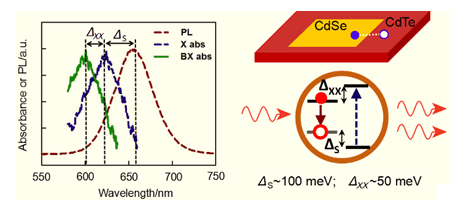摘要/Abstract

胶质纳米晶光增益材料对于开发新一代的高效激光器前景巨大.采用外延生长法制备原子尺寸厚度的Ⅱ型CdSe/CdTe复合纳米片,研究该异质结构的光学性质及其对应的电荷动力学过程,以此探讨其光增益性能及激光应用潜能.光谱结果表明,Ⅱ型纳米片有效的电子与空穴分离结构使其表现出较大的斯托克斯位移(△S=100 meV)和较强的激子-激子库伦排斥力(△XX=50 meV).△S和△XX的协同效应使"激子-双激子"吸收能相比单激子发射能提高了约150 meV,打破了一般纳米晶结构中两者的简并关系,这将有效抑制光吸收损失并促进单激子光增益.单激子光增益机制下该纳米片较长的单激子寿命(τx=394 ns)使连续激光泵浦的理论功率阈值低至12 W/cm2,这为开发实用性更强的、超低阈值的连续波激光器提供可能.
关键词: 激光阈值, II型CdSe/CdTe纳米片, 激子-激子排斥力, 单激子光学增益
Solution-processed optical gain materials hold considerable promise for next-generation, low-cost, highly-flexible laser devices. Examples of such materials are colloidal zero-dimensional (0D) quantum dots, quasi-1D nanorods, and quasi-2D semiconductor nanoplatelets or colloidal quantum wells. Following the first successful demonstration of a lasing regime in colloidal semiconductor nanostructures, this field has experienced tremendous growth motivated by unique features of these materials beneficial to lasing applications. Despite considerable progress over the past decade, colloidal nanocrystal lasing is still not a commercial technology. With few yet-to-be confirmed exceptions, the realization of the nanocrystal lasing regime requires excitation with short and intense pump pulses (typically produced by complex femtosecond laser amplifiers), which greatly diminishes the practical value of this technology. Gain thresholds in colloidal nanostructures, however, are typically high due to the requirement of creating multiple excitons for population inversion. Additional complications arise from a quick depletion of optical gain due to nonradiative Auger recombination of gain-active multi-carrier species. Here, we propose an integrated approach to achieving low-threshold lasing using colloidal nanostructures. We plan to combine previous approaches such as interface engineering and type-Ⅱ hetero-structuring with single-exciton optical gain for achieving record low lasing thresholds and potentially demonstrating lasing action with continuous wave pumping. Atomically-thin CdSe/CdTe Type-Ⅱ heteronanoplatelets (NPLs) were synthesized by lateral epitaxial growth. We have conducted evaluation of optical properties of the CdSe/CdTe type-Ⅱ NPLs with focus on their potential applications in lasing technologies. The studies of CdSe/CdTe type-Ⅱ NPLs indicate that they have the spectral and dynamical properties desired for single-exciton optical gain and continuous wavelength (cw)-pumped lasing. Specifically, due to the effective separation of electrons and holes into different domains in the type-Ⅱ NPLs, they exhibit large Stokes shift (△S=100 meV) and strong exciton-exciton repulsion (△XX=50 meV) for the realization. The sum of these two factors shifts the single-exciton emission energy from the exciton-to-biexciton absorption energy by about 150 meV, strongly suppressing absorption loss and facilitating single-exciton optical gain. Based on the single-exciton optical gain mechanism, the long single-exciton lifetime (τx=394 ns) of CdSe/CdTe NPLs enables a cw-pump power intensity threshold as low as about 12 W/cm2, which offers the possibility to develop more practical cw-pumped lasers with very low lasing thresholds.
Key words: lasing threshold, type-II CdSe/CdTe nanoplatelets, exciton-exciton repulsion, single-exciton optical gain
PDF全文下载地址:
点我下载PDF
